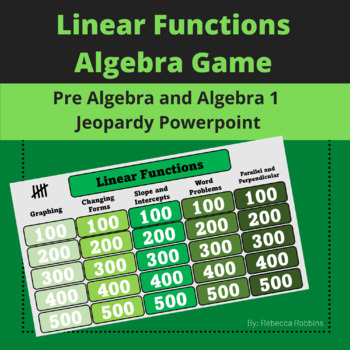Linear Functions Game Algebra Jeopardy Review PowerPoint
- PPTX
Also included in
- These no prep Algebra 1 Review Games are a great way for your students to practice the major topics covered in the first half of Algebra 1 in a fun Jeopardy style game format. Topics for each PowerPoint include: Solving Multi Step Equations, Solving Inequalities, Linear Functions, Systems of EquatioPrice $22.50Original Price $25.00Save $2.50
- These no prep Algebra 1 Review Games are a great way for your students to practice the major topics covered in Algebra 1 in a fun Jeopardy style game format. Topics for each PowerPoint include: Solving Multi Step Equations, Solving Inequalities, Linear Functions, Systems of Equations and InequalitiePrice $36.00Original Price $40.00Save $4.00
Description
This no prep linear functions review game is a great Pre Algebra or Algebra 1
review of linear equations and slope. This power point jeopardy style game will make reviewing all things linear equations fun for your students. Questions include a variety of problem types and difficulty levels including word problems and review of formulas. Topics include graphing, changing forms of linear equations (slope intercept to standard to point slope), slope and intercepts, word problems, and parallel and perpendicular lines.
This game contains 25 questions on the 5 topics listed above. Questions increase in difficulty as the point values go up. Each question also has a matching answer slide with the question still included and all work shown. A digital score keeping slide is also included for up to 3 teams.
What's included?
- 55 slide PowerPoint presentation
- 5 questions on each topic: graphing, changing forms of linear equations, slope and intercepts, word problems, and parallel and perpendicular lines.
- Answer slides for each question with work shown
- Digital score board if playing in teams (max of 3 teams)
Be sure to give my store a follow at Mrs Robbins Math and check out these other resources.
Writing Linear Equations Football Project
End of Year Algebra 1 Jeopardy Bundle
Happy Teaching,
Mrs. Robbins







